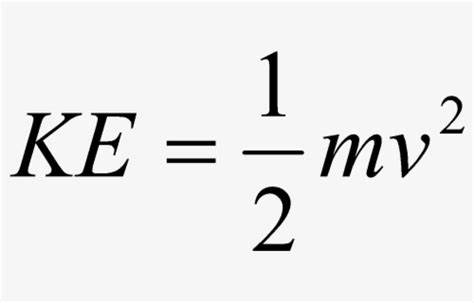
Kinetic energy (KE) is the energy an object possesses due to its motion. It's one of the fundamental concepts in physics and is defined as the energy that an object has because of its velocity (speed) and mass. In other words, when an object is in motion, it has kinetic energy associated with that motion.
The formula for kinetic energy is:

Where:
- KE represents the kinetic energy in joules (J).
- m is the mass of the object in kilograms (kg).
- v is the velocity (speed) of the object in meters per second (m/s).
Also Check - Energy formula
Key points about kinetic energy:
- Depends on Mass and Velocity : Kinetic energy is directly proportional to both the mass and the square of the velocity of the object. This means that increasing either the mass or the velocity will increase the kinetic energy.
- Scalar Quantity : Kinetic energy is a scalar quantity, meaning it only has magnitude (a numerical value) and no direction. It's always positive or zero and does not have a directional component.
- Conservation of Energy: According to the law of conservation of energy, the total mechanical energy (which includes both kinetic and potential energy) of an isolated system remains constant if there are no external forces acting on it. This principle is often used in various physical problems.
- Units: The SI unit of kinetic energy is the joule (J), which is equivalent to one kilogram-meter squared per second squared (1 kg·m^2/s^2).
In practical terms, kinetic energy helps describe how fast an object is moving and how much "energy of motion" it possesses. For example, a speeding car has a significant amount of kinetic energy, and a slowly moving object has less kinetic energy. Understanding kinetic energy is essential in many areas of physics and engineering, particularly in the analysis of motion and collisions.
Also Check - Work Done in Raising a Box Formula
Formula:
Kinetic Energy (KE) = 1/2 * mass (m) * velocity (v) 2
Details:
- Kinetic Energy (KE): This is the energy an object possesses due to its motion. It's measured in joules (J).
- Mass (m): The mass of the object in kilograms (kg). Mass represents the amount of matter in the object.
- Velocity (v): The velocity or speed of the object in meters per second (m/s). Velocity is a vector quantity, meaning it has both magnitude (speed) and direction.
Also Check - Transmission of Heat Formula
Examples:
Let's calculate the kinetic energy for various objects with different masses and velocities.
Example 1: A car with a mass of 1000 kg is traveling at a velocity of 25 m/s.
KE = 1/2 * 1000 kg * (25 m/s)^2 = 312,500 J
Example 2: A baseball with a mass of 0.145 kg is thrown at a velocity of 40 m/s.
KE = 1/2 * 0.145 kg * (40 m/s)^2 = 116 J
Example 3: A bicycle with a mass of 15 kg is moving at 10 m/s.
KE = 1/2 * 15 kg * (10 m/s)^2 = 750 J
Example 4: A bullet with a mass of 0.005 kg has a velocity of 500 m/s.
KE = 1/2 * 0.005 kg * (500 m/s)^2 = 625 J
Example 5: A sprinter with a mass of 70 kg running at 9 m/s.
KE = 1/2 * 70 kg * (9 m/s)^2 = 2835 J
Example 6: An airplane with a mass of 150,000 kg flying at 300 m/s.
KE = 1/2 * 150,000 kg * (300 m/s)^2 = 6,750,000,000 J (or 6.75 GJ)
Example 7: A tennis ball with a mass of 0.057 kg is served at 50 m/s.
KE = 1/2 * 0.057 kg * (50 m/s)^2 = 71.25 J
Example 8: A rocket with a mass of 1000 kg accelerates to a velocity of 4000 m/s.
KE = 1/2 * 1000 kg * (4000 m/s)^2 = 8,000,000,000 J (or 8 GJ)
Example 9: A child on a swing with a mass of 30 kg reaches a maximum velocity of 2 m/s.
KE = 1/2 * 30 kg * (2 m/s)^2 = 60 J
Example 10: A soccer ball with a mass of 0.43 kg is kicked at a velocity of 20 m/s.
KE = 1/2 * 0.43 kg * (20 m/s)^2 = 172 J
These examples illustrate how kinetic energy depends on both the mass and the square of the velocity of an object. Objects with greater mass or higher velocity have more kinetic energy.
=Kinetic Energy Foemula FAQs
What's the difference between kinetic energy and potential energy?
Why is the square of velocity in the kinetic energy formula?
Can an object have kinetic energy at rest?
Is kinetic energy conserved in all types of collisions?










